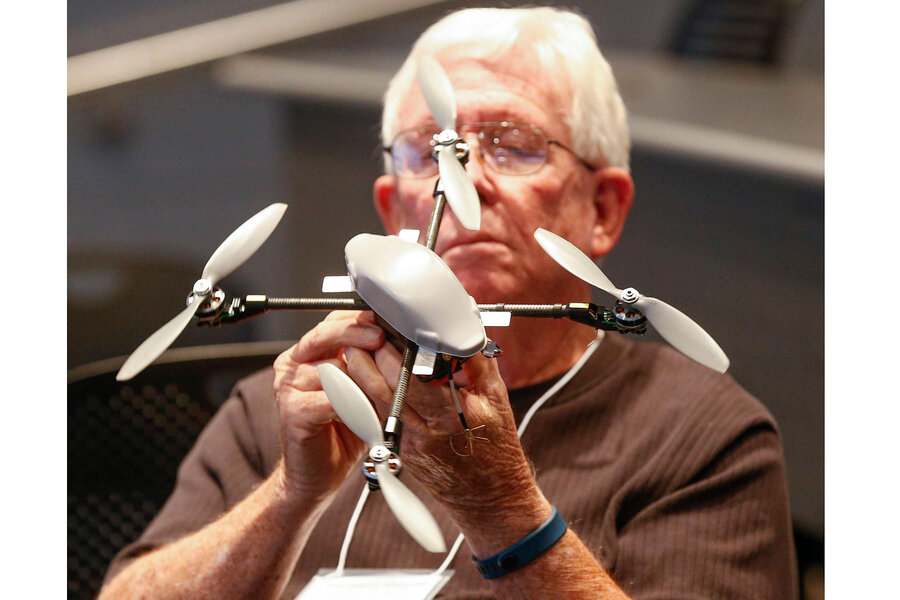Half a million drones in the US, now poised to go mainstream
It's not the first time drones have ended up at the White House, but this time, they came by invitation.
Leaders from the drone industry met with leaders of relevant government agencies from the post office to NASA on Tuesday, as the White House hosted the first-ever drone workshop. The official event highlighted a shift in the government approach, finally creating a clear path for the legal operation of commercial drones. At the same time, a spike in the number of drones in operation and a dramatic decrease in cost are converging to create a tipping-point moment for the technology.
In a few short years, drones have moved from a niche interest or renegade technology to an industry with mainstream value.
Brian Wynne, the president of the Association for Unmanned Vehicle Systems International (AUVSI) that co-hosted the event, called it a landmark in the aviation world, noting that the commercial drone industry had taken the unusual step of asking for government regulation.
"I think we’ve got the balance [between government and industry] right now," Mr. Wynne says. "Now we’re actually getting things done in a much more timely fashion."
Tuesday's meeting came with the announcement that the Federal Aviation Agency has registered more than 500,000 drones since December alone, Quartz reported. The FAA's first-ever regulations for small commercial drones – long-awaited rules that missed several deadlines before their June 21 publication – take effect on Aug. 29.
Until then, commercial drone operators, mostly pilots who are using drones in fields such as agriculture, mapping, or even firefighting, have to keep using a complicated exemption process to fly legally. Working through the red tape to obtain such an exemption, says Ryan Wood of Rocky Mountain Unmanned Systems, can easily take six months.
Adding to the stress of established drone operators has been the explosion of new, affordable drone technology, driving down drone prices and driving up competition.
Drone equipment that today costs $1,000 would have cost $10,000 just three years ago, says Mr. Wood. This has enabled non-pilots, often hobbyists or racers, to experiment or just play around with drones. Some high-profile incidents where drones interfered with wildfire fighting or crash-landed on the White House lawn have hurt their reputation overall.
Establishing clear guidelines for drone flying will help the core of drone professionals to encourage would-be pranksters or crash-landers to follow the rules, Wynne says. For one thing, the new regulations require commercial operators to obtain a license in a manner similar to a driver's license.
Furthermore, the regulations represent a public acknowledgement of drones' potential – the first step toward the industry developing a self-sustaining culture of its own.
"We don’t want the FAA to hire hundreds and hundreds and hundreds of enforcement agents – there’s just too many aircrafts, and there’s going to be millions of drones," Wynne explains. But "once someone is certified, and they start earning their living with these kinds of services, they’re going to be out there making sure that nothing puts that in jeopardy."
He expects the emergence of a clear, legal path to professional drone use to quickly persuade industries that have never flown before to experiment with their use. Electrical companies, for example, could someday use a drone to help remove overgrown tree branches, perhaps sparing a worker from a harnessed climb hundreds of feet above the ground.
Now that commercial drones are seen as rich with economic potential – including a projected 100,000 new jobs and $82 billion growth for the US economy in the next 10 years – initiatives such a mentoring program between drone-flying women and young girls, or another to train military veterans to fly drones commercially, can begin in earnest.
"As a former Marine, I look forward to helping military veterans gain easier access to this rapidly growing industry,” said Dan Burton, the chief executive officer of DroneBase, a company that includes in its mission helping veterans with training and job placement in the drone industry.
Although the operators who have already been using the exemption plan will have an advantage, Wood says he expects to see hundreds of new operators apply for a license in his area alone. Many are already booked to take the test on the day it opens.







